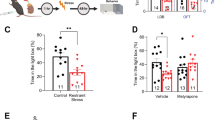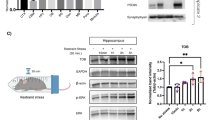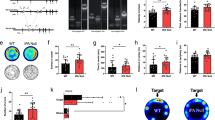Abstract
Although neuronal stress circuits have been identified, little is known about the mechanisms that underlie the stress-induced neuronal plasticity leading to fear and anxiety. Here we found that the serine protease tissue-plasminogen activator (tPA) was upregulated in the central and medial amygdala by acute restraint stress, where it promoted stress-related neuronal remodeling and was subsequently inhibited by plasminogen activator inhibitor-1 (PAI-1). These events preceded stress-induced increases in anxiety-like behavior of mice. Mice in which the tPA gene has been disrupted did not show anxiety after up to three weeks of daily restraint and showed attenuated neuronal remodeling as well as a maladaptive hormonal response. These studies support the idea that tPA is critical for the development of anxiety-like behavior after stress.
This is a preview of subscription content, access via your institution
Access options
Subscribe to this journal
Receive 12 print issues and online access
$209.00 per year
only $17.42 per issue
Buy this article
- Purchase on Springer Link
- Instant access to full article PDF
Prices may be subject to local taxes which are calculated during checkout







Similar content being viewed by others
References
Selye, H. A syndrome produced by diverse nocuous agents. Nature 138, 32 (1936).
Holsboer, F. The rationale for corticotropin-releasing hormone receptor (CRH-R) antagonists to treat depression and anxiety. J. Psychiatr. Res. 33, 181–214 (1999).
Allen, J.P. & Allen, C.F. Role of the amygdaloid complexes in the stress-induced release of ACTH in the rat. Neuroendocrinology 15, 220–230 (1974).
Rogan, M.T. & LeDoux, J.E. Emotion: systems, cells, synaptic plasticity. Cell 85, 469–475 (1996).
McEwen, B.S. Corticosteroids and hippocampal plasticity. Ann. NY Acad. Sci. 746, 134–142 (1994).
Lisman, J.E. Relating hippocampal circuitry to function: recall of memory sequences by reciprocal dentate-CA3 interactions. Neuron 22, 233–242 (1999).
Magarinos, A.M., Verdugo, J.M. & McEwen, B.S. Chronic stress alters synaptic terminal structure in hippocampus. Proc. Natl. Acad. Sci. USA 94, 14002–14008 (1997).
Vyas, A., Mitra, R., Shankaranarayana Rao, B.S. & Chattarji, S. Chronic stress induces contrasting patterns of dendritic remodeling in hippocampal and amygdaloid neurons. J. Neurosci. 22, 6810–6818 (2002).
Chen, Z.L. & Strickland, S. Neuronal death in the hippocampus is promoted by plasmin-catalyzed degradation of laminin. Cell 91, 917–925 (1997).
Baranes, D. et al. Tissue plasminogen activator contributes to the late phase of LTP and to synaptic growth in the hippocampal mossy fiber pathway. Neuron 21, 813–825 (1998).
Nicole, O. et al. The proteolytic activity of tissue-plasminogen activator enhances NMDA receptor-mediated signaling. Nat. Med. 7, 59–64 (2001).
Mars, W.M., Zarnegar, R. & Michalopoulos, G.K. Activation of hepatocyte growth factor by the plasminogen activators uPA and tPA. Am. J. Pathol. 143, 949–958 (1993).
Sappino, A.P. et al. Extracellular proteolysis in the adult murine brain. J. Clin. Invest. 92, 679–685 (1993).
Qian, Z., Gilbert, M.E., Colicos, M.A., Kandel, E.R. & Kuhl, D. Tissue-plasminogen activator is induced as an immediate-early gene during seizure, kindling and long-term potentiation. Nature 361, 453–457 (1993).
Tsirka, S.E., Rogove, A.D. & Strickland, S. Neuronal cell death and tPA. Nature 384, 123–124 (1996).
Tsirka, S.E., Gualandris, A., Amaral, D.G. & Strickland, S. Excitotoxin-induced neuronal degeneration and seizure are mediated by tissue plasminogen activator. Nature 377, 340–344 (1995).
Madani, R. et al. Enhanced hippocampal long-term potentiation and learning by increased neuronal expression of tissue-type plasminogen activator in transgenic mice. EMBO J. 18, 3007–3012 (1999).
Salles, F.J. & Strickland, S. Localization and regulation of the tissue plasminogen activator-plasmin system in the hippocampus. J. Neurosci. 22, 2125–2134 (2002).
Gray, T.S., Carney, M.E. & Magnuson, D.J. Direct projections from the central amygdaloid nucleus to the hypothalamic paraventricular nucleus: possible role in stress-induced adrenocorticotropin release. Neuroendocrinology 50, 433–446 (1989).
Herman, J.P., Prewitt, C.M. & Cullinan, W.E. Neuronal circuit regulation of the hypothalamo-pituitary-adrenocortical stress axis. Crit. Rev. Neurobiol. 10, 371–394 (1996).
Hastings, G.A. et al. Neuroserpin, a brain-associated inhibitor of tissue plasminogen activator is localized primarily in neurons. Implications for the regulation of motor learning and neuronal survival. J. Biol. Chem. 272, 33062–33067 (1997).
Yamamoto, K. et al. Plasminogen activator inhibitor-1 is a major stress-regulated gene: implications for stress-induced thrombosis in aged individuals. Proc. Natl. Acad. Sci. USA 99, 890–895 (2002).
Adams, J.P. & Sweatt, J.D. Molecular psychology: roles for the ERK MAP kinase cascade in memory. Annu. Rev. Pharmacol. Toxicol. 42, 135–163 (2002).
Impey, S., Obrietan, K. & Storm, D.R. Making new connections: role of ERK/MAP kinase signaling in neuronal plasticity. Neuron 23, 11–14 (1999).
Davis, S., Vanhoutte, P., Pages, C., Caboche, J. & Laroche, S. The MAPK/ERK cascade targets both Elk-1 and cAMP response element- binding protein to control long-term potentiation-dependent gene expression in the dentate gyrus in vivo. J. Neurosci. 20, 4563–4572 (2000).
Benowitz, L.I. & Routtenberg, A. GAP-43: an intrinsic determinant of neuronal development and plasticity. Trends Neurosci. 20, 84–91 (1997).
Thorsell, A., Carlsson, K., Ekman, R. & Heilig, M. Behavioral and endocrine adaptation, and up-regulation of NPY expression in rat amygdala following repeated restraint stress. Neuroreport 10, 3003–3007 (1999).
Luiten, P.G., Koolhaas, J.M., de Boer, S. & Koopmans, S.J. The cortico-medial amygdala in the central nervous system organization of agonistic behavior. Brain Res. 332, 283–297 (1985).
McEwen, B.S. Stress and hippocampal plasticity. Annu. Rev. Neurosci. 22, 105–122 (1999).
McEwen, B.S. & Sapolsky, R.M. Stress and cognitive function. Curr. Opin. Neurobiol. 5, 205–216 (1995).
McEwen, B.S. The neurobiology and neuroendocrinology of stress implications for post-traumatic stress disorder from a basic science perspective. Psychiatr. Clin. North Am. 25, 469–494 (2002).
Fanselow, M.S. & LeDoux, J.E. Why we think plasticity underlying Pavlovian fear conditioning occurs in the basolateral amygdala. Neuron 23, 229–232 (1999).
Rogan, M.T., Staubli, U.V. & LeDoux, J.E. Fear conditioning induces associative long-term potentiation in the amygdala. Nature 390, 604–607 (1997).
Gualandris, A., Jones, T.E., Strickland, S. & Tsirka, S.E. Membrane depolarization induces calcium-dependent secretion of tissue plasminogen activator. J. Neurosci. 16, 2220–2225 (1996).
Parmer, R.J. et al. Tissue plasminogen activator (t-PA) is targeted to the regulated secretory pathway. Catecholamine storage vesicles as a reservoir for the rapid release of t-PA. J. Biol. Chem. 272, 1976–1982 (1997).
Neuhoff, H., Roeper, J. & Schweizer, M. Activity-dependent formation of perforated synapses in cultured hippocampal neurons. Eur. J. Neurosci. 11, 4241–4250 (1999).
Nakagami, Y., Abe, K., Nishiyama, N. & Matsuki, N. Laminin degradation by plasmin regulates long-term potentiation. J. Neurosci. 20, 2003–2010 (2000).
Yepes, M. et al. Regulation of seizure spreading by neuroserpin and tissue-type plasminogen activator is plasminogen-independent. J. Clin. Invest. 109, 1571–1578 (2002).
Huang, Y.Y. et al. Mice lacking the gene encoding tissue-type plasminogen activator show a selective interference with late-phase long-term potentiation in both Schaffer collateral and mossy fiber pathways. Proc. Natl. Acad. Sci. USA 93, 8699–8704 (1996).
Frey, U., Muller, M. & Kuhl, D. A different form of long-lasting potentiation revealed in tissue plasminogen activator mutant mice. J. Neurosci. 16, 2057–2063 (1996).
Chapman, P.F. & Chattarji, S. Synaptic plasticity in the amygdala. in The Amygdala (ed. Aggleton, J.P.) 117–153 (Oxford Univ. Press, 2000)
Kim, Y.H., Park, J.H., Hong, S.H. & Koh, J.Y. Nonproteolytic neuroprotection by human recombinant tissue plasminogen activator. Science 284, 647–650 (1999).
Zhuo, M. et al. Role of tissue plasminogen activator receptor LRP in hippocampal long- term potentiation. J. Neurosci. 20, 542–549 (2000).
Chen, Z.L. et al. Expression and activity-dependent changes of a novel limbic-serine protease gene in the hippocampus. J. Neurosci. 15, 5088–5097 (1995).
Schafe, G.E. et al. Activation of ERK/MAP kinase in the amygdala is required for memory consolidation of pavlovian fear conditioning. J. Neurosci. 20, 8177–8187 (2000).
Glowinski, J. & Iversen, L. Regional studies of catecholamines in the rat brain. 3. Subcellullar distribution of endogenous and exogenous catecholamines in various brain regions. Biochem. Pharmacol. 15, 977–987 (1966).
Acknowledgements
This study was supported by National Institutes of Health grants NS-35704 and NS-38472. We thank Z-L. Chen for sharing his expertise in immunohisto-chemistry, P. Mercado and Y. Keptsi for technical assistance, and the members of Strickland Lab for discussion.
Author information
Authors and Affiliations
Corresponding author
Ethics declarations
Competing interests
The authors declare no competing financial interests.
Rights and permissions
About this article
Cite this article
Pawlak, R., Magarinos, A., Melchor, J. et al. Tissue plasminogen activator in the amygdala is critical for stress-induced anxiety-like behavior. Nat Neurosci 6, 168–174 (2003). https://doi.org/10.1038/nn998
Received:
Accepted:
Published:
Issue Date:
DOI: https://doi.org/10.1038/nn998
This article is cited by
-
Blood tissue Plasminogen Activator (tPA) of liver origin contributes to neurovascular coupling involving brain endothelial N-Methyl-D-Aspartate (NMDA) receptors
Fluids and Barriers of the CNS (2023)
-
Modulations of the neuronal trafficking of tissue-type plasminogen activator (tPA) influences glutamate release
Cell Death & Disease (2023)
-
miR-483-5p offsets functional and behavioural effects of stress in male mice through synapse-targeted repression of Pgap2 in the basolateral amygdala
Nature Communications (2023)
-
PACAP-PAC1R modulates fear extinction via the ventromedial hypothalamus
Nature Communications (2022)
-
TOB is an effector of the hippocampus-mediated acute stress response
Translational Psychiatry (2022)



